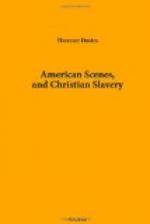In 1838 official notice was given to the inhabitants of the town of Fairfield, in Ohio, that all “black or mulatto persons” residing there were to comply with the requirements of the law of 1807 within twenty days, or it would be enforced against them. The proclamation addresses the white inhabitants in the following remarkable terms: “Whites, look out! If any person or persons employing any black or mulatto person, contrary to the 3rd section of this law, you may look out for the breakers!”
At the very time I was in Ohio an attempt was made, in Mercer County, to eject by force a number of inoffensive black people. Originally slaves in Virginia, they had been liberated by the will of their late master, and located on a suitable quantity of land which he had secured for them. But the magnanimous and liberty-boasting Americans would not allow them to enjoy their little settlement unmolested; and it was extremely doubtful whether the Governor would be able to protect them from outrage.
In 1839 a number of coloured inhabitants of Ohio addressed a respectful petition to the Legislature, praying for the removal of certain legal disabilities under which they were labouring. The answer was a denial, not merely of the prayer of the petition, but of the very right of petition! “Resolved, that the blacks and mulattoes who may be residents within this State have no constitutional right to present their petitions to the General Assembly for any purpose whatsoever; and that any reception of such petitions on the part of the General Assembly is a mere act of privilege or policy, and not imposed by any expressed or implied power of the Constitution!”
But the blackest of these black laws is the following: “That no black or mulatto person or persons shall hereafter be permitted to be sworn, or give evidence in any court of record or elsewhere in this State, in any cause depending, or matter of controversy, when either party to the same is a white person; or in any prosecution of the State against any white person!”




